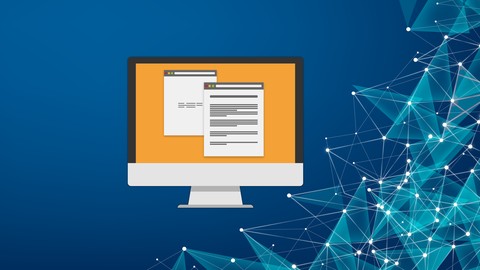
JavaScript for Coders: Learn OOP in JavaScript
JavaScript for Coders: Learn OOP in JavaScript, available at $44.99, has an average rating of 3.45, with 55 lectures, based on 87 reviews, and has 558 subscribers.
You will learn about Master Professional JavaScript Learn to look under the hood and build better apps Master Concepts such as Inheritance, Encapsulation and Polymorphism using live examples Become a better JavaScript Developer This course is ideal for individuals who are Students who want to learn and master advance JavaScript should take this course It is particularly useful for Students who want to learn and master advance JavaScript should take this course.
Enroll now: JavaScript for Coders: Learn OOP in JavaScript
Summary
Title: JavaScript for Coders: Learn OOP in JavaScript
Price: $44.99
Average Rating: 3.45
Number of Lectures: 55
Number of Published Lectures: 55
Number of Curriculum Items: 55
Number of Published Curriculum Objects: 55
Original Price: $29.99
Quality Status: approved
Status: Live
What You Will Learn
- Master Professional JavaScript
- Learn to look under the hood and build better apps
- Master Concepts such as Inheritance, Encapsulation and Polymorphism using live examples
- Become a better JavaScript Developer
Who Should Attend
- Students who want to learn and master advance JavaScript should take this course
Target Audiences
- Students who want to learn and master advance JavaScript should take this course
Do you love coding in JavaScript, but are struggling to master advance JavaScript concepts? Also, does creating sound design pattern for your apps seem a little difficult? Shouldn’t there be a better way for writing codes where a little code can perform a herculean task? There is! It’s object-oriented JavaScript.
JavaScript works well with OOP (object-oriented programming) because of three major techniques that simplify coding for developers – Inheritance, Polymorphism and Encapsulation.
Object-oriented programming also allows developers to contain pieces of codes that can be encapsulated within an object, which can then be called numerous times in the application without having to write the code again. Another benefit of OOP JavaScript is prototype-based inheritance, compared to classes based, which allows an object to directly inherit from another object.�
You will learn how to maximize your code using OOP and JavaScript, as well as so much more in this comprehensive course.�
In our object-oriented JavaScript course, you will learn how to perfectly blend the practicality of object-oriented programming with the functionality of JavaScript to write codes that are clean, concise and perform exactly the way you want them to.
The course will begin with a quick refresher on JavaScript and its basic fundamentals, with an emphasis on important concepts such as closures and prototypes. It will then progress to understanding object-oriented programming principles and how they can be integrated with JavaScript. You will also learn OOP concepts such as encapsulation, inheritance, etc. and how they can be used to enhance your JavaScript codes.
The tutorial will also include how OOP and JavaScript will perform in browsers with reference to Document Object Model (DOM) and Browser Object Model (BOM). The course comes packed with many coding examples, which the learners are definitely encouraged to try on their own.�
Let OOP JavaScript simplify your codes and your life. Click Enroll now!
Course Curriculum
Chapter 1: Introduction
Lecture 1: Introduction
Chapter 2: Object-oriented programming
Lecture 1: Object-oriented programming concepts Part A
Lecture 2: Object-oriented programming concepts Part B
Chapter 3: Primitive data types
Lecture 1: What you need to remember
Lecture 2: The "NUMBER" DATA Type
Lecture 3: STRINGS
Lecture 4: BOOLEANS
Lecture 5: ARRAYS Part A
Lecture 6: ARRAYS Part B
Lecture 7: The switch statement Part A
Lecture 8: The switch statement Part B
Chapter 4: Functions
Lecture 1: The heart of JavaScript
Lecture 2: Well-known functions: ParseFloat
Lecture 3: Variable scope
Lecture 4: Functioms are variables Part A
Lecture 5: Functioms are variables Part B
Chapter 5: Objects
Lecture 1: Connecting the dots
Lecture 2: Object constructors
Lecture 3: Which object belongs to which constructor
Lecture 4: JavaScript built-in objects
Lecture 5: Functions are also objects
Lecture 6: The call() method applied usage
Lecture 7: The Boolean wrapper
Lecture 8: The string() function
Lecture 9: The Math global object
Lecture 10: Introduction to Regular Expressions Part A
Lecture 11: Introduction to Regular Expressions Part B
Chapter 6: Prototype
Lecture 1: The prototype Part A
Lecture 2: The prototype Part B
Lecture 3: Limitations of object enumeration Part A
Lecture 4: Limitations of object enumeration Part B
Chapter 7: Inheritance
Lecture 1: The javaScript way
Lecture 2: Climbing the prototype chain Part A
Lecture 3: Climbing the prototype chain Part B
Lecture 4: Calling parent class methods
Lecture 5: Inheriting from object literals Part A
Lecture 6: Inheriting from object literals Part B
Lecture 7: Using both type of inheritance together
Chapter 8: The Browser Environment
Lecture 1: JavaScript in action
Lecture 2: The navigator object
Lecture 3: The history object
Lecture 4: The screen object
Lecture 5: Scheduled execution
Lecture 6: DOM nodes
Lecture 7: Navigating from a given node
Lecture 8: Event handling
Lecture 9: AJAX flagship: the XMLHttpRequest object
Chapter 9: Design Patterns
Lecture 1: Best coding practices and JavaScript Desin Patterns
Lecture 2: Using namespaces
Lecture 3: Method chaining
Lecture 4: Design patterns: the singleton Part A
Lecture 5: Design patterns: the singleton Part B
Lecture 6: Design patterns: the decorator
Chapter 10: summary
Lecture 1: summary
Lecture 2: Bonus Lecture: More Interesting Stuff, Offers and Discounts
Instructors
-
Eduonix Learning Solutions
1+ Million Students Worldwide | 200+ Courses -
Eduonix-Tech .
Rating Distribution
- 1 stars: 7 votes
- 2 stars: 4 votes
- 3 stars: 11 votes
- 4 stars: 22 votes
- 5 stars: 43 votes
Frequently Asked Questions
How long do I have access to the course materials?
You can view and review the lecture materials indefinitely, like an on-demand channel.
Can I take my courses with me wherever I go?
Definitely! If you have an internet connection, courses on Udemy are available on any device at any time. If you don’t have an internet connection, some instructors also let their students download course lectures. That’s up to the instructor though, so make sure you get on their good side!
You may also like
- Best Video Editing Courses to Learn in February 2025
- Best Music Production Courses to Learn in February 2025
- Best Animation Courses to Learn in February 2025
- Best Digital Illustration Courses to Learn in February 2025
- Best Renewable Energy Courses to Learn in February 2025
- Best Sustainable Living Courses to Learn in February 2025
- Best Ethical AI Courses to Learn in February 2025
- Best Cybersecurity Fundamentals Courses to Learn in February 2025
- Best Smart Home Technology Courses to Learn in February 2025
- Best Holistic Health Courses to Learn in February 2025
- Best Nutrition And Diet Planning Courses to Learn in February 2025
- Best Yoga Instruction Courses to Learn in February 2025
- Best Stress Management Courses to Learn in February 2025
- Best Mindfulness Meditation Courses to Learn in February 2025
- Best Life Coaching Courses to Learn in February 2025
- Best Career Development Courses to Learn in February 2025
- Best Relationship Building Courses to Learn in February 2025
- Best Parenting Skills Courses to Learn in February 2025
- Best Home Improvement Courses to Learn in February 2025
- Best Gardening Courses to Learn in February 2025























